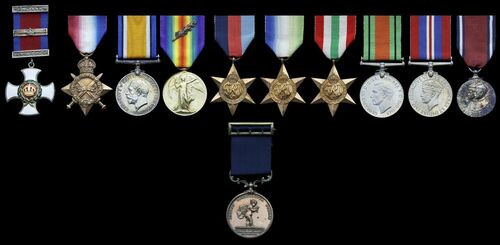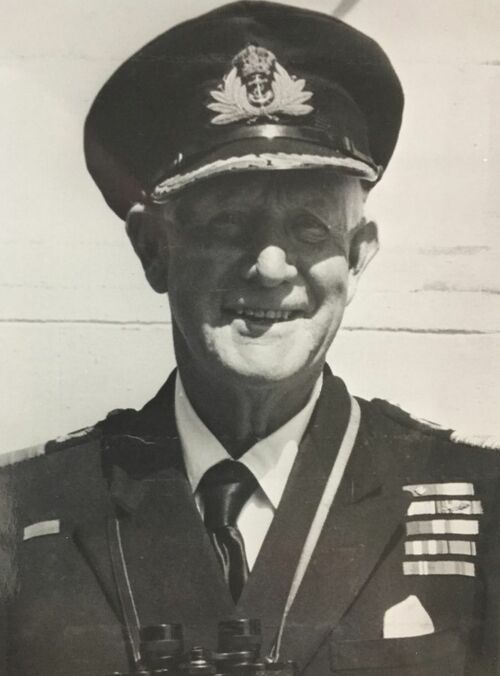Auction: 24002 - Orders, Decorations and Medals
Lot: 172
A rare Great War D.S.O. and Second Award Bar group of eleven awarded to Rear-Admiral C. H. G. Benson, Royal Navy, known by some as 'the King' of mine-sweeping operations
Distinguished Service Order, G.V.R., with Second Award Bar, silver-gilt and enamel; 1914-15 Star (Lt. Commr. C. H. G. Benson, R.N.); British War and Victory Medals, with M.I.D. oak leaves (Commr. C. H. G. Benson. R.N.); 1939-45 Star; Atlantic Star; Italy Star; Defence and War Medals 1939-45, all engraved 'Commodore C. H. G. Benson R.N.R.', Jubilee 1935; Royal Humane Society bronze Medal (Lt. Cdr. Cyril H. G. Benson. R.N. 1st Nov. 1915.), overall good very fine (11)
In British Gallantry Awards, Abbott and Tamplin state that the Admiralty approved a total of just 52 Second Award Bars to the D.S.O. in the Great War.
D.S.O. London Gazette 7 August 1918:
'In recognition of great gallantry displayed in carrying out especially dangerous mine-sweeping operations.'
Second Award Bar to D.S.O. London Gazette 24 March 1919:
'For services in mine-sweeping operations between 1 July and 31 December 1918.'
Cyril Herbert Gordon Benson was born in Croydon, Surrey on 17 February 1884, the son of James Bourne Benson, and was educated at Winchester and in Britannia, which latter establishment he entered as a Cadet in May 1899. A talented young officer, he was advanced to Lieutenant on H.M.S. Good Hope in March 1906 and was awarded the Shadwell Testimonial Prize for a survey undertaken in the sloop Algerine of the Punta de Parinas, Peru in 1909-10.
By the outbreak of hostilities in August 1914, Benson was serving as a recently promoted Lieutenant-Commander in the cruiser Essex, which captured the Bethania - tender to the German raider Kaiser Wilhelm der Grosse - on 7 September 1914. After further patrols in the sea lanes between the Caribbean and Halifax, Essex returned to home waters and joined the Grand Fleet.
On 1 November 1915, owing to an accident when hoisting a boat, six men from Essex's ship's company were thrown into the sea. Benson jumped in and assisted in getting all the men on board. He was awarded the Bronze Medal of the Royal Humane Society (R.H.S. Case No. 42,240, refers).
The 'King' of mine-sweeping
Benson's remarkable mine-sweeping career commenced with his appointment to the trawler Oropesa in the 5th M./S. Flotilla at Stromness in the Orkneys in November 1916. Described in one report as an officer 'who takes risks on his own initiative' and gets the job done, he was advanced to Commander in December 1917 and awarded the D.S.O. in August 1918. Ongoing glowing reports of his gallantry and initiative led to him being gazetted for a Bar to his D.S.O. in March 1919.
Benson then added a 'mention' to his accolades in a final list of honours for his services as C.O. of the Mine Clearance Force in the Northern Area (London Gazette 22 January 1920, refers), by which time he had been appointed Director of mine-sweeping affairs at the Admiralty. During these immediate post-war clearance operations, he invented the 'Oropesa Sweep', a method of clearing moored mines by a towed wire.
He also - in 1919 - married May Florence Boyd, who obtained a decree nisi in 1941. Judging by a report written by Admiral Frederic Dreyer in the years ahead, Benson was likely relieved by her application for divorce:
'I think it is also important that consideration should be given to the fact that Captain Benson's wife is a woman of a very pushing and egotistical type, who also appears to consider the wives of the officers of her husband's ship as entirely at her beck and call. I have never met any other woman who is so cordially disliked and avoided as Mrs. Cyril Benson.'
Unaware of such blots on his service record, Benson led the 4th Destroyer Flotilla in 1926-28 and commanded the Royal Australian Naval College at Captain's Point, Jervis Bay in 1929-31. Later still, he served as Second Naval Member of the Royal Australian Naval Board in 1930-32.
An interlude on the China Station having ensued in 1933-35, when he commanded the cruiser Cumberland, he was placed on the Retired List as a Rear-Admiral in 1936. But he appears to have been a reluctant retiree, instead taking up appointment as a Commandant in the R.A.F.V.R. at Hull.
Commodore of Convoys
On the renewal of hostilities, he was appointed to the Harwich shore establishment Badger, his service record noting as a Commodore 2nd Class, R.N.R. for command of auxiliary M./S. craft.
Having then served at the Rosyth shore establishment Cochrane from March 1940 to July 1943, he joined the Liverpool base Eaglet as a Commodore of Convoys and, on taking up a similar appointment at Cormorant, he participated in several cross-Atlantic trips in early 1945.
Benson's final appointment was as C.O. of radar establishment Valkyrie on the Isle of Man in 1945-47, where he hosted a visit by the King and Queen, and he reverted to the Retired List in the latter year.
Keen golfer
A talented golfer, the Admiral - who was a member of the Royal and Ancient Golf Club at St. Andrews - appears in several post-war newspaper reports, one of them comparing his performance in his 80s to a budding Jack Nicklaus.
But his name in such circles will probably be best remembered for an incident that occurred at the Royal Birkdale. The Sunday Times of 24 November 1964, takes up the story:
'It was some 20 yards short of this unseen hazard [a hidden bunker] that the attention of the retired Admiral was attracted towards the stern of a trim little craft in red trousers playing her third shot to the adjacent 7th. What thoughts were in the veteran sea-dog's mind we cannot tell, but a moment later, with this pleasing image before his eyes, he vanished with a clatter from human sight and only a volley of nautical oaths revealed to his companions where he and all his clubs has sunk.'
The bunker in question was duly christened 'Benson's Bunker.'
The Admiral was 'an officer of great charm' who appears to have been 'liked by all', except his ex-wife, and died on Hayling Island, Hampshire in March 1974, aged 90; sold together with copied research.
For the recipient's miniature dress Medals see Lot 303.
Subject to 20% VAT on Buyer’s Premium. For more information please view Terms and Conditions for Buyers.
Sold for
£3,000
Starting price
£1900







